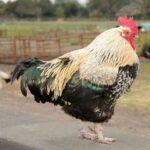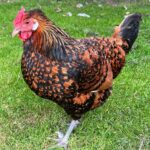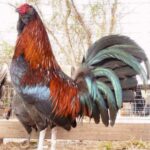Most chickens will stop laying eggs while molting. Molting typically occurs each year when sunlight hours are decreasing in the lead-up to winter. Chickens will spend anywhere between 8-16 weeks regrowing their feathers, and may not lay until after winter.
Table of Contents
Why Do Chickens Molt?
Molting (also spelled moulting in other parts of the world) is a process most animals with hair or feathers go through where they shed their current plumage to make way for new.
Chickens’ feathers go through a lot during the year. If you take a close look, you’ll almost certainly see signs of wear, bits of feathers missing, some broken and chipped barbs, and some crooked feathers on your flock.
This is why chickens - and birds in general - molt. It’s basically a case of out with the old damaged feathers, and in with the shiny new ones for a new season.
I should also point out that there is also a possibility that molting is due to health issues. Or more accurately, loss of feathers that looks like molting.
Chickens living in stressful environments may have patchy plumages, as will chickens that are not getting a balanced nutritional intake.
You’ll know the difference though. If you have healthy chickens that have been laying well all year and it’s coming up to winter, they’re going to be molting.
What Are the Signs of Chickens Molting?
It’s not hard to spot the signs that a chicken is molting - their feathers start falling out!
It tends to happen in patches and gradually over many weeks. Don’t worry, you’re not going to suddenly be greeted by a flock of bald chickens!
You’ll first notice they’re looking a bit thin in places. Their plumage will be more disheveled than usual, and you’ll also see feathers all over their coop and on the ground.
You may also notice their combs a paler than usual and they’re acting more reserved. This is normal, molting puts quite a toll on their bodies.
Generally speaking, molting is triggered by daylight hours reducing as winter draws near. This is because molting is also a time when chickens stop laying eggs as they need to give their reproductive organs a rest and channel nutrients into feather growth.
Most chickens halt egg production in the winter anyway. Chickens need a good 14 hours of natural light a day to lay at their best, so taking a break and molting makes perfect sense.
Related - Here's a close look at why chickens stop laying eggs in the winter.
How Long Do Chickens Molt For?
There are different stages of molting. Baby chicks molt pretty early on as they transition from that baby chick fuzz to real feathers.
Baby chicks typically molt with four cycles around the ages of:
- 2-5 weeks
- 6-10 weeks
- 13-16 weeks
- 20-23 weeks
Most breeds will be transitioning from pullets into mature laying adults from 24 weeks onwards. From this point on, they will typically molt once a year when they’re cycling out of laying ready for winter.
It can take anywhere from 8-16 weeks for a chicken to complete the molting phase. Not all molting seasons will be the same, either.
Younger chickens tend to go through a molt quicker than older ones, as you’d probably expect. The quality of their nutrition also plays a part, and you just never know how long it’s going to take.
How Long Before Chickens Lay Eggs After Molting?
Chickens can return to laying eggs shortly after they’ve finished molting. As long as the basic factors important to egg production are met, there’s no reason why they will not start laying again if they’re in good health.
This means, you need to ensure your chickens have:
- Quality layer feed (containing around 16% protein, calcium, and the other key minerals they need).
- 14+ hours of good natural daylight per day.
- Stress-free living conditions.
- Good overall health and are in laying age etc.
As long as they’re not molting and have all these basic needs, your chickens will start laying.
How to Help a Chicken That's Molting
Molting takes a pretty heavy toll on a chicken. There are some things you can do to make it easier for them:
Increase Their Protein Intake
Feathers are made from keratin, this is the same protein found in hair and nails. Molting chicks need all the protein they can get to up their production of keratin.
Switching to a complete feed with 20% protein is going to put less stress on their bodies. Also, if you can allow them to free-range and find insects and bugs to eat that’s a bonus.
Related - You can check out how much chickens typically eat in this post.
Pamper Them a Little
Coming off a hard year laying (hundreds?) of eggs, I think the least you can do is pamper your hens a little while they’re replacing their feathers.
Anything you can do to give them more space to roam is a plus. The last thing they want to be doing is rubbing into stuff and bumping into other chickens. A few tasty treats will not go amiss, too.
Transition Back Onto Layer Feed
When spring is approaching and the daylight hours are increasing, think about transitioning back into laying mode.
Start switching over to a layer feed with plenty of calcium. Make sure their nesting boxes are in good order, and prepare to start finding delicious eggs!
In Summary
If you’re witnessing a molt for the first time, it’s both magical - and a little scary!
It’s perfectly normal though, and you’re going to see your flock go through this once a year at least.
All you can do is let nature take its course and provide the best possible nutrition and living conditions to help your hens through their molt.
They’ll come out the other side with a brand new looking coat and be back to laying within 16 weeks or so at the latest, I’m sure.
Resources
Image credits - Header photo by mana5280 on Unsplash




